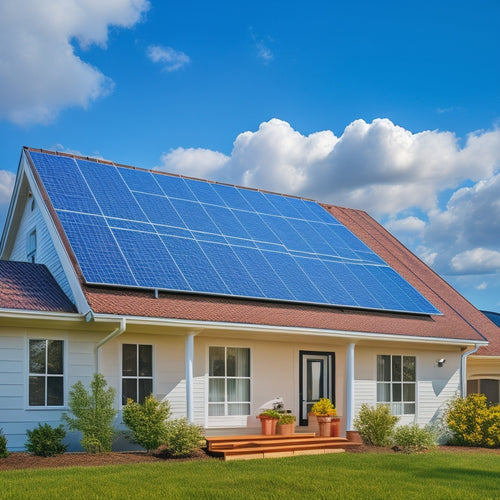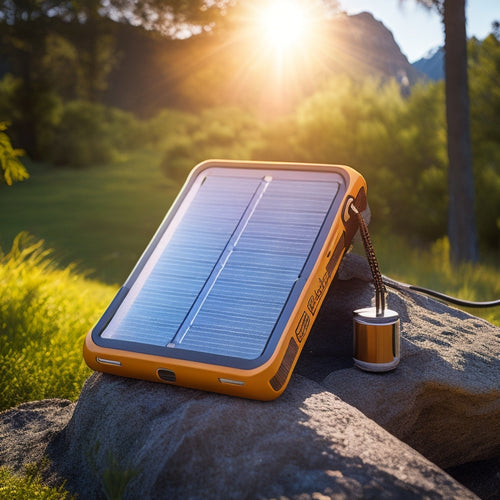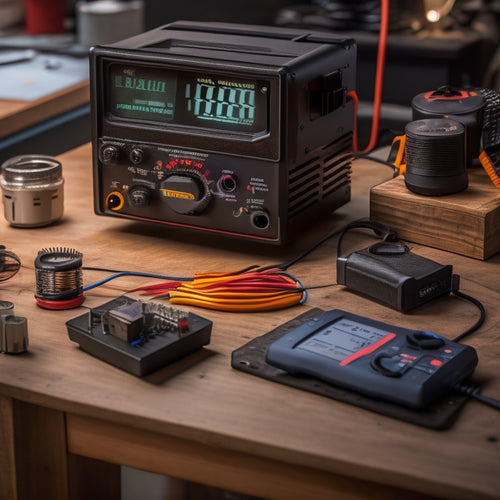
Renovate With Renewable Energy: a Homeowner's Guide
Share
You're taking a significant step towards reducing your home's environmental footprint and energy bills by considering a renovation with renewable energy, and with solar power being a viable option, you can now utilize the cleanest and most abundant energy source available. Solar power systems promote energy independence, lower energy bills, and minimize environmental impact, requiring minimal maintenance and lasting up to 30 years. Evaluating your home's solar potential, choosing the right panels, and designing the best system are essential steps in the process. As you steer through the ins and outs of solar energy, you'll uncover the perfect solution for your home, customized to your unique needs and goals.
Key Takeaways
- Assess your home's solar potential by evaluating roof size, orientation, and pitch, and identifying shading obstructions.
- Choose the right solar panels based on efficiency, warranty, and manufacturer reputation to ensure optimal performance.
- Consider different solar power system design options, such as grid-tie, off-grid, and hybrid systems, to suit your energy needs.
- Research and take advantage of local incentives and rebates available for solar installations, including federal tax credits and state rebates.
- Evaluate the long-term benefits of solar energy, including reduced energy bills and minimal maintenance, to offset the high upfront costs.
Benefits of Solar Power Systems
With the increasing awareness of climate change and the need to reduce our reliance on fossil fuels, solar power systems have emerged as a viable alternative for homeowners and businesses alike.
By installing a solar power system, you'll be taking a significant step towards energy independence, reducing your reliance on the grid and lowering your energy bills. Furthermore, you'll be minimizing your environmental impact, as solar energy is a clean and renewable source of power.
You'll also be contributing to a reduction in greenhouse gas emissions, which is essential for mitigating climate change. Additionally, solar power systems require minimal maintenance and can last for up to 30 years, making them a sustainable and cost-effective option for the long haul.
By embracing solar power, you can empower your community through collective solar investments, enhancing independence and promoting self-sufficiency.
With significant reduction in monthly utility bills, you can guarantee predictable cost savings and better budgeting.
Assessing Your Home's Solar Potential
Your home's solar potential is a crucial factor in determining the effectiveness of a solar power system. Before installing a system, you need to assess your home's ability to utilize solar energy.
A solar site assessment evaluates your home's solar potential by analyzing factors such as roof size, orientation, and pitch. It also includes a shading analysis to identify any obstructions that could impact energy production. This analysis considers the impact of trees, buildings, and other structures on your roof's exposure to sunlight.
To guarantee accurate load calculation, it's vital to calculate total daily energy consumption from all devices and create an energy profile listing device power ratings and daily usage hours.
Choosing the Right Solar Panels
You've narrowed down your solar panel options to a few top contenders, but now it's time to dig deeper.
When evaluating panel efficiency, look for the highest percentage rating, as it directly impacts the amount of energy produced. Typically, high-efficiency panels range from 20-22%.
Next, scrutinize solar warranties, which typically cover equipment and performance. Look for extensive warranties that guarantee at least 80% of the original power output for 25 years or more.
Consider pairing your solar panels with a reliable deep cycle battery, such as Trojan Battery, to guarantee consistent power output in extreme temperatures.
Additionally, consider the manufacturer's reputation, durability, and certifications, such as UL (Underwriters Laboratories) or IEC (International Electrotechnical Commission) marks.
Installation and Maintenance Costs
Beyond the initial investment in solar panels, it's essential to take into account the installation and maintenance costs that will impact your overall return on investment.
These costs can add up quickly, but being aware of them will help you plan and budget accordingly.
Here's what you can expect:
-
Installation timeline: The installation process typically takes 2-5 days, depending on the complexity of the job and the size of your system.
-
Labor costs: You'll need to factor in labor costs for the installation team, which can range from $2,000 to $5,000.
-
Maintenance tips: Regular cleaning and inspections will help guarantee your system operates at peak efficiency; consider budgeting $100-$300 per year for maintenance.
Solar Power System Design Options
When designing a solar power system, you'll need to evaluate which type of system best fits your energy needs and budget.
You can opt for a grid tie system, which connects to the grid and allows you to sell excess energy back to the utility company.
Alternatively, you might choose off grid living, hybrid power solutions, or a combination of these options to achieve energy independence.
Grid Tie Systems
As homeowners consider their solar power system design options, grid tie systems emerge as a popular choice.
You're likely drawn to the benefits of grid tie systems, which include:
-
Reduced electricity bills: Grid tie systems allow you to generate your own electricity and export any excess to the grid, offsetting your consumption.
-
Increased property value: Installing a grid tie system can enhance your property's value, making it more attractive to potential buyers.
-
Low maintenance: With no batteries to maintain, grid tie systems are relatively hassle-free.
However, you should also be aware of the challenges.
For instance, grid tie systems require a connection to the grid, which may not be feasible in areas with outdated infrastructure.
Additionally, you'll need to ascertain that your system meets local building codes and regulations.
Off Grid Living
Your remote cabin in the woods beckons, and you're considering solar power to fuel your off-grid lifestyle. To achieve energy independence, you'll need a solar power system that can meet your energy demands.
For off-grid living, you'll require a battery bank to store excess energy generated during the day for nighttime use or during periods of low sunlight. A deep cycle battery bank, such as lithium-ion or lead-acid, is ideal for this application.
Additionally, consider integrating a sustainable water system, like a rainwater harvesting system, to reduce your reliance on municipal water supplies.
When designing your system, verify you've accurately sized your solar array and battery bank to meet your energy needs, and consider consulting with a professional to assure a reliable and efficient off-grid energy system.
Hybrid Power Solutions
You're likely considering multiple solar power system design options to optimize your energy independence, and hybrid power solutions can offer a reliable and efficient approach.
By combining solar power with energy storage, you can guarantee a steady supply of electricity even when the sun isn't shining. Hybrid systems integrate solar panels with other power sources, such as wind or diesel generators, to provide a consistent flow of energy.
Here are three benefits of hybrid power solutions:
-
Reliability: Hybrid systems can provide backup power during grid outages or periods of low sunlight.
-
Efficiency: By optimizing energy production and storage, hybrid systems can reduce your reliance on non-renewable energy sources.
-
Cost-effectiveness: Hybrid power solutions can help you save money on energy costs by reducing your dependence on the grid.
Local Incentives and Rebates Available
Local governments and utility companies are offering attractive incentives to homeowners who renovate with renewable energy.
You can benefit from federal incentives, such as tax credits, and state rebates that can greatly reduce the upfront cost of your project.
Additionally, local programs provide financing options and rebates for energy-efficient upgrades. For instance, you may be eligible for a rebate from your utility company for installing energy-efficient appliances or solar panels.
Be sure to research the incentives available in your area, as they can vary widely.
Overcoming Common Solar Objections
You're considering solar energy for your renovation, but you've likely heard some common objections that are holding you back.
You might be worried about the high upfront costs, or you've heard that solar panels are inefficient or will ruin your home's aesthetic appeal.
Let's take a closer look at these concerns and investigate the facts behind them.
High Upfront Costs
Several factors contribute to the high upfront costs of solar energy systems, making them a significant barrier to adoption for many homeowners.
You may be thinking, "Isn't solar energy expensive?" Yes, it can be. However, it's crucial to evaluate the long-term benefits.
Here are some key factors affecting the upfront costs:
-
Equipment costs: The cost of solar panels, inverters, and mounting hardware can be substantial.
-
Installation costs: Labor costs, permits, and inspections add to the overall expense.
-
System design and engineering: Customizing a system to meet your energy needs requires knowledge and time.
Fortunately, financing options can help mitigate these costs.
Myth of Inefficiency
As solar energy becomes increasingly popular, one misconception continues to hinder its adoption: the notion that solar panels are inefficient. You may have heard that solar panels don't produce enough energy to power your home, or that they're too expensive to be worth the investment. But these solar myths are just that – myths.
| Energy Misconception | Reality |
|---|---|
| Solar panels are too inefficient | Modern solar panels have an average efficiency rate of 20-22% |
| Solar energy is too expensive | The cost of solar energy has decreased by 70% over the last decade |
| Solar panels don't work in cloudy weather | Solar panels can still generate energy on cloudy days, although at a lower rate |
| Solar panels require frequent maintenance | Solar panels require little to no maintenance and are designed to last 25-30 years |
| Solar energy isn't reliable | Solar energy is a reliable source of energy, with many systems lasting 30 years or more |
Aesthetics Concerns
Now that we've dispelled the myth of inefficiency, another common obstacle to solar adoption comes into focus: aesthetics concerns.
You might worry that solar panels will alter your home's appearance, detracting from its curb appeal. However, modern solar panels are designed to be sleek and unobtrusive, blending seamlessly into your roof's design.
Consider the following ways to address aesthetics concerns:
- Color selection: Choose panels that match your roof's color, ensuring a harmonious visual integration.
- Design integration: Opt for panels that are specifically designed to complement your roof's style, whether modern, traditional, or anything in between.
- Roof layout: Strategically place panels to minimize visual impact, such as hiding them behind skylights or vents.
Frequently Asked Questions
Can I Install Solar Panels on a Rented Property?
You'll need to review your rental agreements and get your landlord's permission before installing solar panels on a rented property, as modifications typically require their consent to guarantee you're not voiding your lease or damaging the property.
How Long Does It Take to Recoup the Investment Cost?
You'll need to conduct an investment analysis to determine your payback period, which varies depending on factors like system size, local incentives, and electricity rates; generally, it takes 5-15 years to recoup the cost of solar panels through energy savings.
Are Solar Panels Resistant to Hail and Extreme Weather?
You're probably wondering if your solar panels can withstand an apocalyptic hailstorm! Rest assured, they're built to last, with rigorous testing ensuring they can resist hail damage and extreme weather conditions, so you can breathe easy knowing your investment is weather-durable.
Can I Use Solar Power to Charge My Electric Vehicle?
You can use solar power to charge your electric vehicle; make certain your solar panel system is EV-compatible and consider a solar charging station with a dedicated 240-volt charging point for efficient and convenient EV charging.
Do Solar Panels Increase My Property's Value?
As you utilize the sun's power, your property's value shines brighter, increasing equity and beckoning potential buyers seeking energy independence; with solar panels, you're not just generating electricity, but a lucrative selling point, illuminating a clear path to a profitable sale.
Related Posts
-

Cost of Solar Panel Installation
You can expect to pay between $15,000 and $30,000 or more for a typical solar panel installation, depending on the sy...
-

Fastest Solar Chargers for Emergency Power
When choosing the fastest solar chargers for emergency power, you need to focus on features like rapid charging capab...
-

Key Features of a DC to AC Converter
A DC to AC converter features high efficiency and conversion rates, which reduce energy costs and improve performance...


